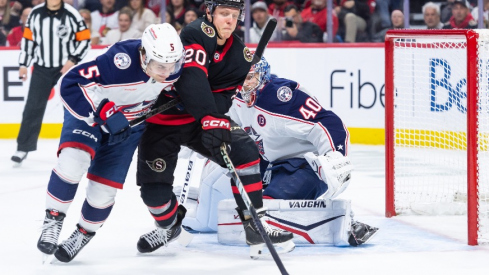Right now is a weird time to talk about hockey analytics, or advanced stats, considering the Pittsburgh Penguins are breaking everything related to them.
On Monday night in Game 1 of the Stanley Cup Finals, the Pens scored five goals on just 12 shots on goal (four tallies in 11 if you take out the empty-netter). This is a shooting percentage of 41.7 (or 36.3), which if, of course, ridiculous.
It's the kind of thing that can happen in a small-sample size environment (nerd-speak for one game, or one series if you want to extrapolate a little further). The 12 shots on goal – including a 37-minute span of game time in which the Pens had (carry the one) ZERO shots on goal – was the lowest for a winning team in a Cup Finals game ever.
This is not to say that the result goes against what analytics believes in. Numbers people understand weird things can happen in small sample sizes, and if you have a 5-on-3 goal, get a goal deflected in off a defenseman, and pop one late, you too can win a Stanley Cup Finals game without peppering one of the top goalies in the world. And if you get really lucky (and have some of the best scorers in the world), you can be outshot (and outscored) in the first three rounds of the playoffs and still make the sport's grandest stage like the Penguins have.
Be that as it may, advanced stats are built on a few assumptions based on both logic and data. Shooting percentages tend to regress to the mean. The more shots on goal (or shot attempts) you have tends to equal more puck possession, which tends over the long haul to lead to more scoring chances and thus more goals and eventually more wins.
Which brings us to the Columbus Blue Jackets, a team that has an old-school coach and old-school president and still embraces the numbers. Not everything the team does, of course, is based on a computer spreadsheet, but the most successful organizations in sports over the past few years have married an understanding of what can be learned from analytics with the traditional way of doing things. That's key as Columbus approaches an offseason looking at ways internal and perhaps external to improve upon the best season in franchise history.
Speaking with Sportsnet's Elliotte Friedman over the weekend, general manager Jarmo Kekalainen – a noted fan of what the new math can tell you – said the team needed to finish with a better shooting percentage than this past year (Columbus was seventh in the league at 9.7 percent) to boost offense when it matters most. That led to this exchange between writer and general manager.
That led to an interesting conversation about shooting percentages, regression and how much he pays attention to it. The short answer: a lot.
“You know if someone is shooting 30 per cent, it’s hard to sustain that. We know that if a player had an unusually low number, there is a chance the next year he comes out of it. We go through an exercise where we predict how many goals we think we are going to score as a team next year. We look at every player.”
First, it would be a heck of a lot of fun to see those numbers the front office puts together predicting how many goals each player will score. It would be like fantasy hockey on steroids. But secondly, it is insightful to see the Jackets brass puts emphasis on such numbers.
That includes, increasingly, head coach John Tortorella. He's known as the oldest of the old school among NHL coaches, but that reputation belies an inquisitive nature that has allowed him to be part of those discussions with the front office.
"I think he's seeing a lot more correlation between the analytics and the way we analyze the game both on the team and the individual level now that he has gotten familiarity," Kekalainen said at the team's exit interviews in April. "(Blue Jackets director of hockey administration) Josh (Flynn) always sends us the email with the analytics after every game broken down by the lines and the combinations and the matchups. We joke after the games, 'Oh, we won the Corsi and we lost the game,' or vice versa, but I'm hearing less and less of that from Torts of late so I'm thinking he's slowly starting to realize that there is a true correlations between the advanced stats and winning."
That last sentence got a guffaw out of team president John Davidson, but Kekalainen continued to say the head coach isn't about to turn his back on anything that can help the team.
"He's very receptive," the GM said. "He will study and he will read. He has his own way of talking about it ('He's Torts," Davidson chipped in here), but he's a smart man. If he sees something and you can prove it to him, he'll always be wiling to listen and talk and explore and have an open mind.
"I think that's a big misconception about him, that he's hard-headed. He's not dumb. He's a smart man. He has an open mind."
"I can honestly say that there's been times when Jarmo has had a study done on something to do with the game," Davidson added, "and Jarmo has gone in and sat down with Torts, and he'll read it and say, 'Yeah, yeah, yeah, OK, I get you. By the way, can you do this for me and get this done?' So he's old school, but he has an open mind. He's good that way."
So as the Blue Jackets approach the month of June and what it takes to improve the franchise, it appears the numbers will continue to be a big part of those discussions.

